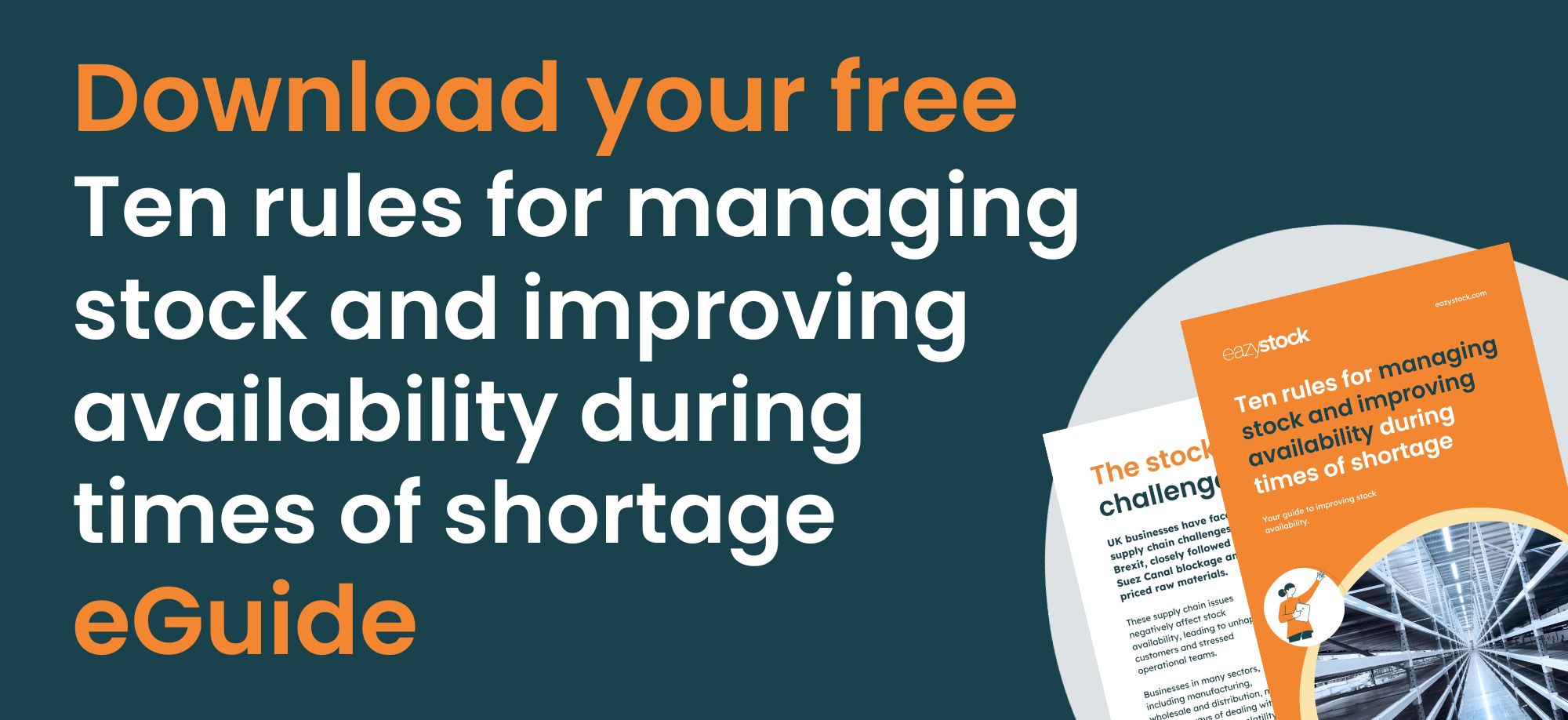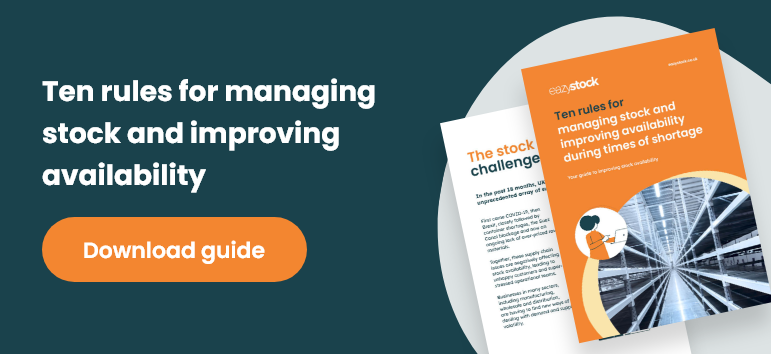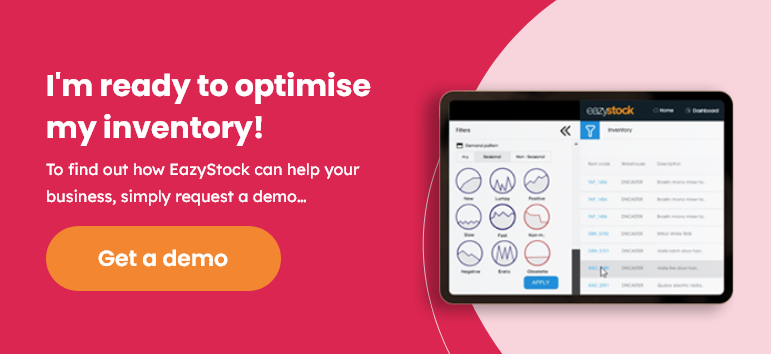5 inventory management techniques to prevent stockouts
The current causes of stockouts
Since the coronavirus pandemic took hold, businesses across the globe have faced stock availability challenges. Delays at manufacturing sites, container shortages and a lack of raw material have all led to stockouts. These issues have arguably been compounded by Brexit causing increased bureaucracy and a lack of HGV drivers making matters worse.
Many inventory management teams are looking for ways to stop stockouts, as they can cause problems right across their organisation. Stockouts are bad for business – they lead to unhappy customers, stressed employees, a poor reputation and a dent in profits.
Unfortunately, there’s no easy solution to deal with the current global supply chain problems and avoid stockouts altogether. However, there are steps you can take to improve your inventory management processes and be better prepared to prevent regular stock availability crises in your business.
Help stop stockouts with a simple risk of stockout report
During times of supply chain disruption, stockouts are inevitable. It is therefore critical that you put measures in place to mitigate their disruption to your business and your customers.
To do this you need to know what stock items are most ‘at risk’ of running out, when are they likely to run out, and by how much you are likely to be short.
If you have this crucial information to hand you can help your team understand their upcoming stock challenges and put a plan in place to deal with the consequences. After all, nobody likes surprises!
Important risk of stockout KPIs include:
- Number of stock days – how many days stock you have left until you run-out
- Shortfall time – the total number of days you will be out-of-stock
- Max shortfall time – the longest time period you will be out-of-stock
- Shortfall quantity – the total amount of units you will have out-of-stock
- Maximum shortfall quantity – the highest number of units you will be out-of-stock
These KPIs can easily be calculated in a ‘risk of stockout’ spreadsheet. Start simple by working out your ‘number of stock days’. This will provide you with dates when stock is due to fall below a specified point. For example, when there is only a day, a week or a month’s worth of stock left, based on the item’s average sales.
A basic risk of stockout spreadsheet can be easily set up using the following data:
- Current stock items, items on order and in transit
- Demand forecasts
- Lead times
Utilising safety stock to help prevent stockouts
When stockouts are a risk, it’s wise to include safety stock in your inventory management calculations. This will give you an additional buffer of stock, in case a delivery is late, or you have an unexpected surge in sales or additional production run.
For example, with the risk of stockout report, you could choose to set out-of-stock alerts at 50% of your safety stock, so ‘out of stock’ will be when you only have 50% of your safety stock left, (so you know you have a little extra as a back-up).
Ensuring your data is accurate and up-to-date
It’s important to stress that your risk of stockout report will only be useful if you have accurate data on your current stock levels, demand forecast and lead times.
If demand and lead times are consistent, you could update your report once a week, maybe less. In a dynamic sales environment with orders changing more often, this would need to be done as often as possible.
Whilst this process sounds time-consuming, you could choose to just focus your report on your most critical or profitable items. Introducing ABC Analysis to categorise your stock would help identify these so you can prioritise your time.
Ways to help avoid stockouts and alleviate the issues
With prior notice that key inventory items are at risk of running out, your team can then put a plan in place to alleviate the issues. Possible options include;
Move stock from elsewhere in the business
If you have stock across multiple sites, double-check for excess inventory sat in warehouses where demand is low. It makes sense to relocate these items to places where sales are more buoyant and help prevent stockouts.
Restrict ordering / sales of ‘at risk’ items
You may want to put order limits on ‘at risk’ items to prevent customers or internal departments placing large orders and wiping out the rest of your limited stock.
In a similar way, you may want to increase ecommerce prices across your digital channels to lower demand, without showing ‘out-of-stock’.
Fast-track an emergency order or find a different supplier

At times when the reliability of your usual suppliers is in question, you may want to diversify. This may mean having suppliers closer to home to prevent shipping delays, or expanding your network across the globe to remove any Brexit-related issues. The aim is to increase your options when you need to economically procure stock in an emergency.
Hold stock back for key accounts
If you have key customers that you can’t let down or accounts that are more profitable than others, you may decide to hold stock back to fulfil their orders first.
Inform customers in advance so they can make other arrangements
Whilst it’s not good practice to let your customers down, if you give them prior warning of your stock availability issues, then they will have more time to look for alternative suppliers. Communication is key during times of supply chain disruption.
Using software to predict when stockouts will occur
Whilst a risk of stockout report will help you understand your upcoming stock limitations, it’s going to take valuable time to set up and manage. The alternative is to use software to produce the report for you.
An inventory optimisation tool, such as EazyStock, connects into your existing stock management system and will automate the risk of stockout calculations for you.
EazyStock takes a feed of your current stock data and uses historical sales to forecast upcoming demand. It then classifies your inventory items, so you know which ones are the most critical to your business.
With system-generated demand data, current stock levels and lead times, EazyStock will produce a risk of run out report at the click of a button. This means you don’t have to spend time on the stockout calculations, instead you can take the data and focus on putting a plan in place to minimise disruption.
If you’d like to know more about how EazyStock can support your inventory management processes and help better manage supply chain disruption please request a demo.











